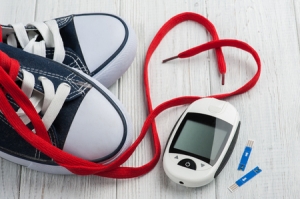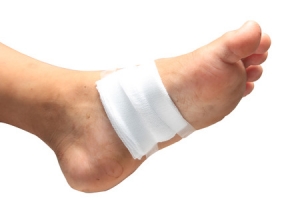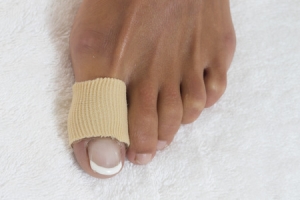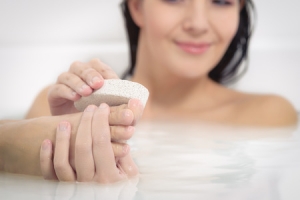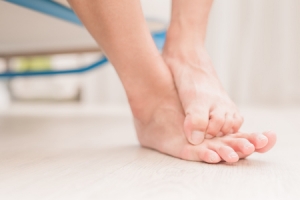Connect With Us
Blogs
Displaying items by tag: ingrown toenails
6 Tips for Protecting Your Feet with Diabetes
At Superior Foot & Ankle Care Center, we know that diabetes can affect your skin, joints, and bones in a number of ways. Two conditions associated with the disease—peripheral arterial disease (PAD) and neuropathy—are of particular concern when it comes to your lower extremities. PAD is a narrowing or blocking of the arteries to your legs, which can lead to poor circulation. This means that nutrient and oxygen-rich blood necessary for healing cannot reach your legs, feet, and toes as quickly as needed. Neuropathy is nerve damage that can result in loss of feeling in your feet, which makes it difficult to perceive pain and injury. This double whammy means that patients with diabetes are at a higher risk for a host of podiatric problems, including:
- Ulcers and wounds that do not heal properly
- Fungal infections
- Hammertoes
- Ingrown toenails
- Corns and calluses
Difficulty healing can cause even minor foot and toe problems to become major threats with the potential for infection and even amputation. Below are some ways you can be proactive in preventing foot problems if you have diabetes:
- Control your blood sugar. Follow all your doctor’s instructions for managing your diabetes. Watch your diet, take your medications as directed and regularly test to make sure you are on track.
- Schedule regular podiatric checkups. Our podiatrists, Victoria M. Foley or Dr. Constance Ornelas, will work with you to prevent potentially dangerous foot issues. Seeing the foot doctor regularly will increase the chances of catching injuries and infections in their very early and most treatable stages. The podiatrist can also help with nail care, wound debridement and diabetic footwear and orthotics.
- Keep feet clean, warm, and dry. Wash daily and dry thoroughly—especially between your toes. Use a foot powder before putting on socks.
- Make sure shoes fit correctly. Avoid styles that have narrow toe boxes are that are made of very stiff materials. Keep the heel height to 2 inches or less.
- Don’t walk barefoot. This dramatically increases your chances of getting athlete’s foot or a fungal toenail infection, which are contracted by direct contact. You are also more likely to step on a sharp object and injure your foot without shoes.
- Conduct regular self-exams—it’s important that between appointments you are checking your feet and toes daily for any signs of rashes, cuts, blisters, bruises, growths or other indicators that a foot problem is developing. If you can’t see your whole foot as a family member or caregiver to assist you. Contact our Long Beach office immediately by calling (562) 420-9800 if you find anything concerning.
A Beautiful Pedicure in 8 Easy Steps
At Superior Foot & Ankle Care Center we know that many of our patients enjoy getting professional pedicures but recent stories in the news about fungal and bacterial infections lurking at some salons may leave you feeling hesitant. If you don’t have a salon you trust to follow proper sanitizing procedures, we want you to know that you can give yourself a relaxing and pretty pedicure at home. Here’s how:
- First remove any old nail polish using cotton balls and nail polish remover.
- Fill a small tub with warm, soapy water and soak your feet for 5-10 minutes. Use a nail brush to gently scrub toenails and then rinse feet with clear water and dry.
- Rub a pumice stone or foot file on rough areas of the foot such as the heel and ball. This will exfoliate dead skin and help smooth calluses. If you have large or deep calluses or corns, make an appointment at our Long Beach office and let our podiatrists, Victoria M. Foley or Dr. Constance Ornelas safely remove or trim them.
- Trim toenails straight across and not too short. File the edges with an emery board. Do not curve the edges downward as this can lead to ingrown toenails.
- Gently push back your cuticles with an orange stick. Cuticles that extend from the nail margins can be trimmed using a cuticle trimmer. Do not cut so close that they bleed.
- Apply moisturizer to the cuticles and then the rest of your feet. Give yourself a soothing foot massage, using your fist to rub the balls of your feet and heel. Massage the top of your foot and your toes as well. You can also roll your feet on a bottle or rolling pin.
- Remove excess lotion from toenails with nail polish remover.
Brush on a base coat, then two coats of your favorite color and a top coat. Put your feet up and allow time for nails to dry completely. Enjoy!
How to Have Healthy Feet
January is a good time for starting new habits, and we at Superior Foot & Ankle Care Center would like to urge patients to make this the year that you commit to better care of your feet. We believe in educating our patients to be proactive about the health of their feet. There are many ways that you can reduce your risk of injury and foot disorders and improve your podiatric health. Below are some suggestions:
- Wash your feet every day with mild soap and warm water. Dry them thoroughly, with particular attention to the area between the toes. This will significantly reduce the risk of athlete’s foot.
- Don’t walk barefoot. Out in public, walking without shoes increase your risk of coming in contact with a fungal infection. Even at home, you can protect your feet from stepping on sharp objects by keeping them covered.
- Get in the habit of inspecting your feet on a regular basis. The best outcomes for foot disorders occur when they are treated in their earliest stages. Being vigilant about reporting changes in skin or nail color, swelling, bumps or growths, bruising and cuts that don’t seem to be healing to our podiatrists, Victoria Foley or Dr. Constance Ornelas, can save you from prolonged and invasive treatments.
- Making wise shoe choices. Did you know that the single most significant step you can take to improve the health of your feet is choosing good shoes? Styles with roomy toe boxes that don’t constrict your toes, adequate arch support and laces for a firm fit can reduce the risk of falls, joint conditions, and toe deformities. In addition, getting away from wearing high heels can prevent neuromas and lessen the chances of bunions and several other podiatric problems.
- Apply sunscreen, not just on beach days but any days when the bare skin of your feet will be exposed in open sandals or shoes to the sun. The skin on your feet is just as susceptible to skin cancer as the skin on the rest of your body.
- Take care of toenails. Keep your nails trimmed straight across and not too short to prevent ingrown toenails from developing.
Better foot care needn’t be complicated or time-consuming. A few simple changes in your daily regimen can make a world of difference. If you have questions regarding the care of your feet, contact our Long Beach office today by calling: (562) 420-9800.
4 Signs Your Child May Have a Foot Disorder
At Superior Foot & Ankle Care Center, we treat patients of all ages. Some of our younger patients are not very articulate about foot and ankle pain or discomfort. Children may know that it doesn’t feel good to run but not be able to specifically say that it feels like a rock is pressing into the ball of their foot or that their toenail is sore. That’s when parents have to do a little detective work. See if you notice one or more of these signs that your child may be experiencing a podiatric problem:
- A loss of interest in games and physical activities they normally love. A usually active child who chooses to sit on the sidelines or complains that they feel too tired to play may be masking the fact that his or her feet hurt.
- Your child is always last. Being unable to keep up with their peers in simple outdoor play or more formal sports settings can indicate an improperly functioning foot.
- He’s “running in a funny way.” If you notice your child’s gait has changed, it may be a sign that they are altering the way they move to avoid pain or discomfort. This will often lead to balance issues and an increase in trips and falls.
- Limping or walking on tiptoes. Younger children may be afraid to go to the doctor or not want to take time out from playing, so they keep going, but a change is evident in how they walk and run. That’s when it’s time to examine your child’s feet and see if there are cuts, bruises, swelling, or other potential sources of foot pain. Ingrown toenails, which are particularly common in children, can quickly become swollen and painful but would not be noticeable unless you inspect your child’s feet. Checking children’s feet regularly is a good way to help detect podiatric issues in their earliest stages. If you notice anything unusual, be sure to report it to our podiatrists, Victoria Foley or Dr. Constance Ornelas, so they can diagnose your child’s condition promptly and prescribe the correct treatment. Contact our Long Beach office for an appointment by calling: (562) 420-9800.
Diabetic Foot Ulcers Can be Prevented
Did you know that the leading cause of lower extremity amputations not caused by trauma is diabetes? And, foot ulcers precede 85 percent of these amputations. At Superior Foot & Ankle Care Center we want patients to know that diabetic foot ulcers can be prevented and our podiatrists, Dr. Victoria Foley and Dr. Constance Omelas will work with you to develop a care regimen and monitor your feet as a diabetic patient. Adhering to a schedule of regular podiatric checkups is an important step in protecting your feet if you have diabetes. Below are other areas where you can be proactive in preventing ulcers:
Healthy Foot Habits—in addition to regular podiatric exams, doing your own self-exams at home is also very important. Foot ulcers commonly form on the soles of the feet so be sure you check the bottom of your feet carefully (or have someone do it for you) and the rest of your feet as well on a daily basis. Report any redness, sores, blisters, rashes or cuts to the foot doctor asap. You should also wash your feet daily and dry completely. Use foot powder and change your socks whenever you notice that your feet feel damp. This will reduce the risk of bacterial and fungal conditions which can lead to infections and wounds.
Footwear—the shoes you wear can play a big part in preventing conditions that can lead to wounds. Choose styles that are made of soft, flexible material and have wide, roomy toe boxes. Shoes that squeeze toes together can increase the risk of ingrown toenails and blisters and hasten the progression of toe problems like hammertoes and bunions. Periodically run your hand around the inside of your shoes to make sure there are no small pebbles stuck inside or loose stitching that can rub against the skin and cause an irritation.
Lifestyle Choices—one of the most important steps you can take for preventing ulcers is keeping your blood sugar levels where they should be. Follow the dietary plan your doctor has given you and fill your menus with nutrient-rich foods that are low in sugar. Don’t smoke because it impedes circulation. Limit alcohol use as this has been linked with an increased risk of foot ulcers.
If you have diabetes and have additional questions about how to best care for your feet and prevent diabetic complications, contact our Long Beach office by calling: (562) 420-9800.
Free Your Feet from Shoes that Hurt
Freedom is a word frequently associated with Independence Day and here at Superior Foot & Ankle Care Center, it’s also a reminder that many patients are wearing shoes that too small for their feet. Improperly fitting shoes is one of the top causes of foot pain and can lead to chronic foot disorders such as plantar fasciitis and fallen arches. Follow the tips below on your next shoe shopping trip to ensure a good fit:
- Don’t buy shoes without trying them on. Even if you think you know your size, fit can vary based on the manufacturer and the shoe style.
- Get your foot professionally measured. There are two good reasons for this. First, most people have two different sized feet. You’ll want to buy shoes to fit the bigger foot. Also, your shoe size may increase as you get older or if you’ve recently given birth.
- Shop at the end of the day. Your feet are at their largest and most swollen after you’ve been on them all day. A common foot shopping faux pas is buying shoes early in the day and then finding when you wear them that you can’t wait to take them off at the end of the day because they make your feet hurt.
- Focus on the toes. Many common toe problems such as bunions, hammertoes, ingrown toenails, and corns are made worse by shoes that have narrow toe boxes. High heels can also force toes into a cramped position. You should be able to wiggle all your toes freely in a properly fitting pair of shoes and there should be at least a half an inch of space between your longest toe and the front of the shoe.
- Avoid styles that are completely flat with no arch support. In addition, if the foot doctor has prescribed an orthotic device, bring it with you and try on with the shoes you are considering.
- Try on both shoes and take your time walking around the store to make sure they are comfortable. When you take the shoes off, check for red marks on your feet which may indicate friction or rubbing from the shoe.
If you are experiencing chronic foot aches and pains, schedule an appointment at our Long Beach office by calling: (562) 420-9800. Our podiatrists, Dr. Victoria Foley or Dr. Constance Omelas will evaluate your feet and determine whether it’s your shoes or another problem that is causing your discomfort.
Do’s and Don’ts for Dealing with Ingrown Toenails
It’s hard to believe how much pain such a tiny part of your body—a toenail—can cause, but if you have one that’s ingrown, you know what we’re talking about. The too-tender-to-touch, swollen, red, hot area surrounding your toe can make it difficult to wear shoes or even walk until it’s treated. At Superior Foot & Ankle Care Center we would like to offer the following tips for treating and preventing ingrown toenails:
Don’t: clip your toenails super short or file them with rounded edges—this encourages the nails to grow inward.
Don’t: wear shoes that are too small or narrow in the toe box. Ditto for socks and tights. Any type of footwear that forces the toes up against each other will increase the chances of ingrown nails.
Do: monitor a nail carefully if you’ve had an injury such as a heavy object fall on it, a bad stubbing or if you have another nail condition such as a fungal infection. In these cases, it is not uncommon for an ingrown nail to form.
Do: check your nails frequently if you are a runner, play soccer or participate in another activity where your toe is repeatedly being pounded up against the front of your shoe. This can cause a nail to become ingrown.
Do: soak your foot in warm water and Epsom salts if you notice a nail is ingrown. This may soften the skin enough so that you can gently massage the corner of the nail out of the skin. It may also bring pain relief.
Do: contact our Long Beach office for an appointment if soaking does not work. Our podiatrists, Dr. Victoria Foley or Dr. Constance Omelas will examine the nail and, if necessary, can perform a minor surgical procedure that will remove part of the nail border. Nails that are chronically ingrown may require the nail root to be removed.
Do: call us immediately at (562) 420-9800 if you notice signs of infection: pus, red streaks, fever.
Don’t: try any “bathroom surgery” or folk remedies to treat or prevent ingrown nails. Techniques like putting cotton under the nail, cutting a notch in a nail or repeatedly trimming nail borders as a new nail grows not only don’t work they can result in injury or infection.
5 Ways to Take Better Care of Your Feet
At Superior Foot & Ankle Care Center we believe in being proactive when it comes to the health of your feet. In honor of Foot Health Awareness Month, we’d like to offer the following tips for taking care of your feet:
- Wear shoes that fit. This is one of, if not the single biggest steps you can take to prevent foot and ankle injuries and disorders. Some studies have shown that up to 90% of people are wearing shoes that are the wrong size! Shoes that are too narrow or tight in the toe box can encourage deformities such as bunions and hammertoes as well as increase the risk of ingrown toenails and fungal infections. Get your foot professionally measured at the shoe store. Shoe size can change as you age and during pregnancy.
- Get in the habit of doing self-exams on your feet. Changes in the skin or nails of your feet, as well as shape, size or color, can all be indicators of potential foot problems. Any differences in sensation (burning, numbness, tingling), swelling or abnormal growths should be reported to our podiatrists, Dr. Victoria Foley and Dr. Constance Omelas promptly. Early detection of a foot problem can mean a better outcome and less invasive treatment.
- Limit time going barefoot. Bare feet in public places are at a higher risk for coming in direct contact with fungi and bacteria that cause infections such as athlete’s foot and fungal toenails. Even at home, however, going barefoot increases your risk of puncture wounds and injuries.
- Don’t neglect foot hygiene. Basic daily care of your feet should include washing with soap and water (and drying completely) as well as applying foot powder or moisturizing lotion, depending on your individual needs. Don’t wear socks more than one day and alternate our shoe choice as well.
- Live a Healthy Lifestyle. You may not think about it but maintaining a healthy weight, exercising and getting regular checkups all contribute to the health and well being of your feet. Be sure that you monitor chronic diseases such as diabetes and arthritis and follow your physicians’ instructions for keeping this conditions under control.
If you have questions about how to best care for your feet, contact our Long Beach office by calling: (562) 420-9800.
Avoiding Common Pediatric Foot Problems
At Superior Foot & Ankle Care Center we find that most children’s podiatric issues result either from poor hygiene habits or overuse injuries related to sports activities. One of the difficulties in diagnosing and treating children is that they are not always able to articulate their symptoms or even identify the source of discomfort. Look for these indicators that your child may be experiencing foot or ankle pain:
- Limping or walking or running in an abnormal way.
- Not wanting to participate in sports or other active pursuits that they normally enjoy.
- Complaints of tiredness.
- An increased frequency of trips and falls.
If your child is showing any of these signs inspect their feet completely (but gently—the cause of the pain may be internal). If you notice anything unusual or you don’t see anything but it’s clear that something is wrong with your child’s feet, make an appointment at our Long Beach office so that one of our podiatrists, Dr. Victoria Foley or Dr. Constance Omelas can do a complete podiatric exam.
Practice Safe Sports
You can help prevent injuries and conditions caused by overuse by ensuring that your child has the correct shoes for the sport they are doing and that the shoes fit properly. When children are young it’s likely that they will need a new pair of shoes each season. Have your child’s feet professionally measured and don’t let them wear hand me down sports shoes. Be sure that children warm up and stretch before practices and games and that the conditioning program they are doing allows days of rest between workouts. Heel pain from plantar fasciitis or Sever’s Disease and Achilles tendonitis are some foot conditions that can be caused by too much repetitive activity from a sport or exercise program.
Teach Your Child Healthy Foot Habits
Plantar warts, athlete’s foot, fungal toenails and ingrown nails are also conditions that children commonly experience. These can be avoided if your child follows some simple rules:
- Let mom or dad trim nails appropriately—don’t peel nails or pull them off.
- Wear shower shoes or flip-flops at the town pool and when in gym locker rooms—fungal and bacterial infections are spread by direct contact.
- Don’t share shoes, socks, towels, nail files or any other items that touch someone else’s foot.
If you have questions about your children’s feet, contact us by calling: 562-420-9800.
6 Ways to Prevent Diabetic Foot Complications
Here at Superior Foot & Ankle Care Center we believe in the importance of good foot care for all or our patients. For those with diabetes, however, extra precautions are necessary. Diabetes has several conditions associated with it that can result in major medical complications being caused by what other patients may deem minor foot issues. A compromised immune system, reduced circulation and neuropathy (or lack of sensation) all require additional measures to keep feet safe and healthy. Below are 6 podiatric tips for patients with diabetes:
- Choose footwear carefully. Shoes should have roomy toe boxes that don’t cramp or squeeze toes together. This will reduce the risk of ingrown toenails. Shoes should be made of natural, breathable materials. Inspect shoes periodically to make sure there are no rough spots, loose stitching or other elements that could rub on the skin and cause a blister or ulcer.
- Watch the heat. Don’t expose feet to high temperatures from fire places or electric blankets. Carefully monitor water temperature in baths and showers. A loss of sensation can result in burns due to the fact that the patient does not perceive pain from heat or burning.
- Stay dry. Fungi love moist, dark places to grow, such as the inside of sweaty socks. Change socks as soon as you notice they are damp to help avoid fungal infections.
- Keep the blood flowing. You can help improve circulation by exercising regularly and not sitting or standing in one position for long periods of time. Don’t cross your legs or wear socks that are tight or have elastic in the top to hold them up.
- Inspect feet daily. Wash your feet in warm soapy water every day and while you do so, check for cuts, blisters, bumps, bruising, swelling, growths or anything unusual or different on your feet. Report any changes to the foot doctor promptly.
- Make your podiatrist a care partner. Regular podiatric checkups with our podiatrists, Victoria M. Foley and Dr. Constance Ornelas can go a long way toward prevent footing health problems. If seen regularly, the foot doctor can detect changes and potential issues in your feet in the very earliest stages and stop problems before they start.
If you are a patient with diabetes and you have questions about the health of your feet, contact our Long Beach office by calling: 562-420-9800.
